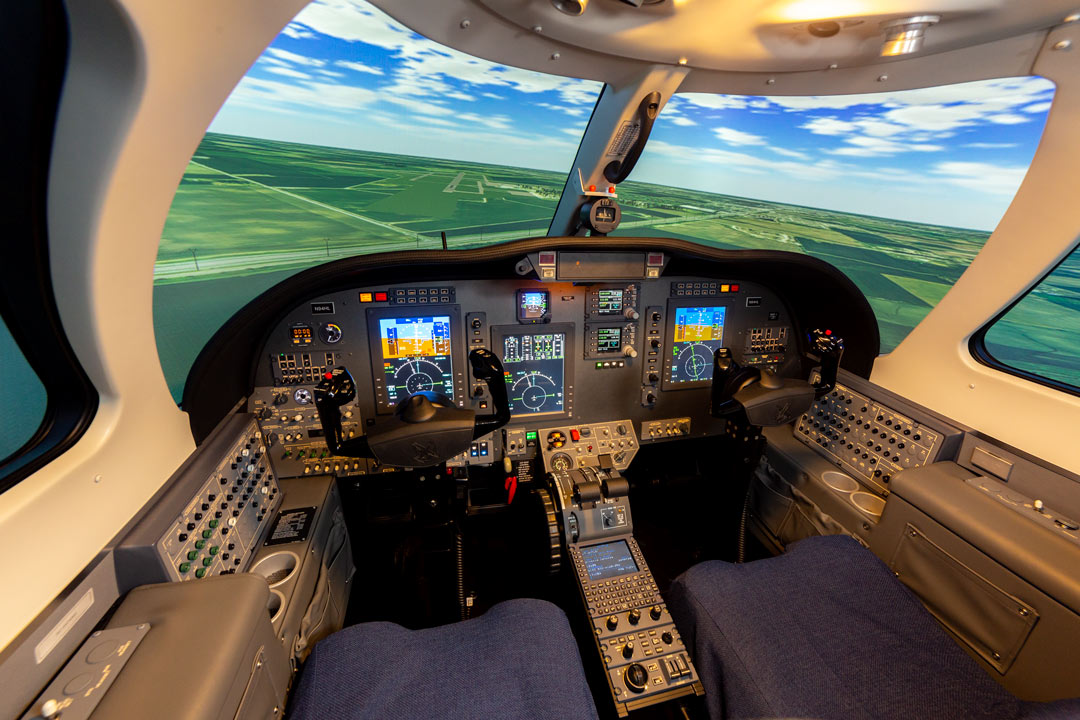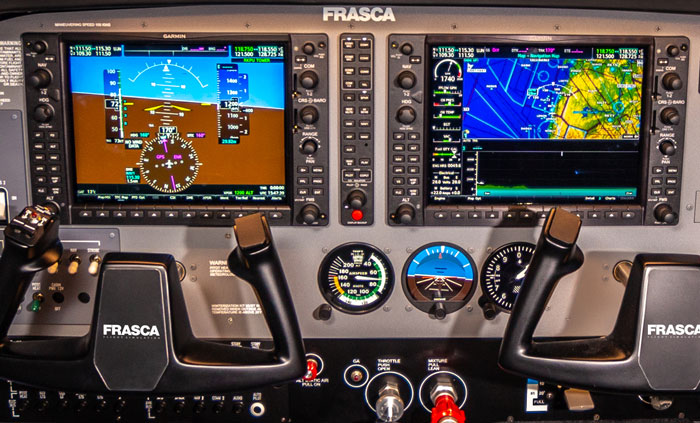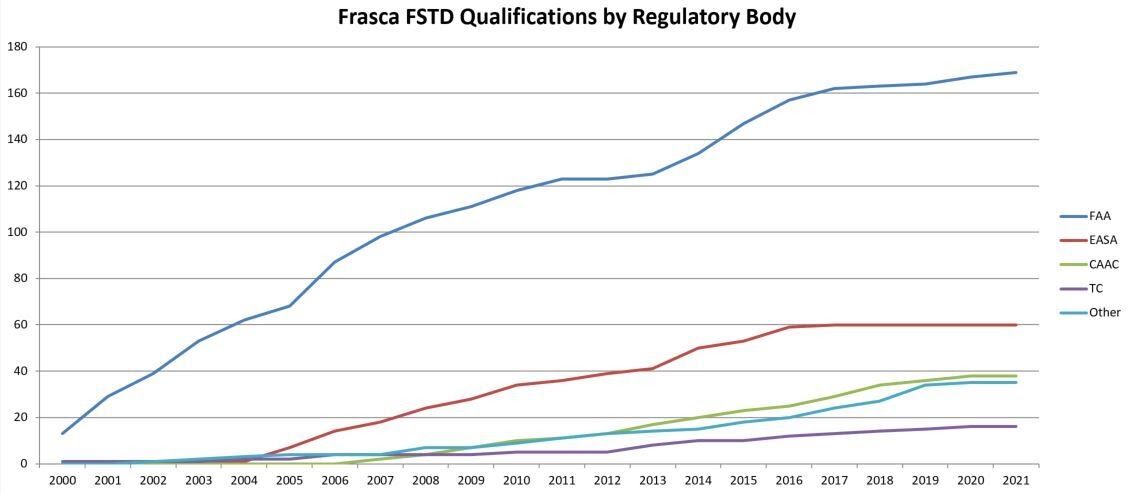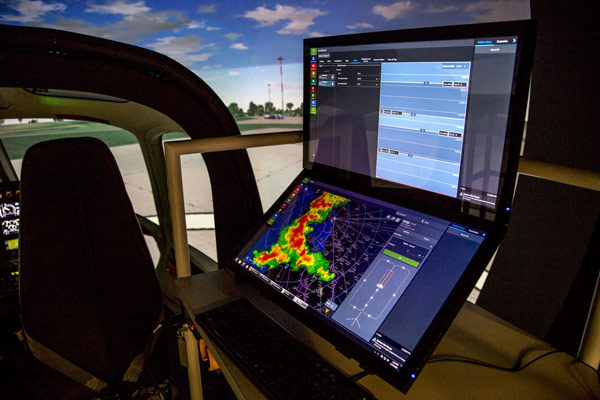- PRODUCTS
- MILITARY
- RESOURCES
- The Ultimate Guide to Selecting the Right Simulator for Your Business
- Brochures
- Customer Features
- Elevating Aviation Training: A Frasca Case Study with Embry-Riddle Aeronautical University’s Prescott, Arizona Campus
- ATP Flight School Purchases 20 Flight Simulators (AATDs) From Frasca to Support Airline Pilot Training
- United Airlines invests in FRASCA simulators for new flight school
- United Aviate Academy
- US Air Force Academy
- Legacy Flight Training Uses Frasca for Piper M600
- How Frasca Is Making Training Safer For Bristow
- Air Evac Lifeteam Trains With Frasca Simulators
- Moody Aviation Partnership With Frasca Spans 50 Years
- Epic Flight Academy Q&A
- Q & A with UND
- Embry Riddle Q&A
- Approvals
- NEWS
- COMPANY
You've decided to purchase a flight simulator. This is a big decision and we're here to help make the buying process easier with information on what to look for, questions to ask and more.
There are multiple vendors offering flight simulators for sale in today’s market. You now have the daunting task of deciding which one to purchase. The purpose of this blog is to provide you with thoughts, knowledge and insight to help you select the best flight simulator for your business. Aviation regulators have many designations for various levels of Flight Simulation Training Devices, such as BATD, AATD, FTD, FNPT, MCC, FFS, etc. A Frasca representative can help you determine the specific level that best meets your requirements. For the purpose of this blog, we will use the general term, “flight simulator”.
A Bit of History
Flight simulators are widely used by flight training organizations worldwide, however this was not always the case. The first mass produced simulator was built in 1929 by Link and didn’t get much use until the Air Force started using them for pilot training in WWII. Over the decades, flight schools, airlines and other organizations began implementing them into their training programs for a variety of reasons, most notably for safety as well as cost effectiveness, mission training, recurrency training and more.
Over time, and as simulators became more realistic, they were more widely used. Today, virtually all collegiate training programs use flight simulators (often AATDs and FTDs) for pilot training, while airlines rely on Full Flight Simulators (FFSs). Military organizations, helicopter operators (med-evac, law enforcement, tourism, etc.) and other businesses involved with pilot training typically use some level of flight simulation device as well.

Buying a Simulator is an Important Decision That Deserves Research
Your simulator selection will impact many facets of your business:
Training Value - A simulator’s training value is directly related to it’s fidelity or realism. It’s extremely important to learn to ‘fly right’ from the start.
In times of stress, such as emergency situations, pilots will revert to the way they first learned a task. If the flight simulator used in their initial training was not accurate to the aircraft, negative training may lead to errors in their decision-making process and final actions, creating a safety hazard. If a student pilot is initially taught something incorrectly, they will have a difficult time correcting bad habits. Conversely, pilots who experienced training in a realistic flight simulator are more likely to perform the correct actions leading to a successful and safe outcome.
Financial – It is important to consider both acquisition (up-front) costs in the short-term and total ownership (life-cycle) costs in the long-term. While it may seem logical to purchase the least expensive flight simulator, overlooking additional operational costs will negate any original savings.
These additional long-term costs can include higher downtime as a result of breakage, decreased revenue due to unscheduled maintenance time, increased labor costs for repairs, decreased useful life if the vendor goes out of business, and lower employee and customer morale due to utilizing an inferior and ineffective simulator.
It’s important to evaluate a flight simulator based on overall value, quality and long-term cost, not simply on the upfront price.
Image / Reputation – While at first glance the equipment you purchase may seem inconsequential in how you define your own program, it’s important to realize that most prospective students will view the equipment you purchase as an indication of the quality of your entire program. Try looking at your purchase from a different perspective and ask yourself these important questions:
How would you like your program to be perceived by your potential students and customers?
If you were a student, how would you feel about your program offering and equipment? Is it worth the investment being asked?
Could you potentially even increase your course offering cost if you had higher quality equipment?
For most people, purchasing a flight simulator is an experience that only happens once in their career. Therefore, you may be learning how to do this at the same time you are actually doing it. For others, especially those operating larger flight school operations, you may need to purchase multiple simulators and are making complicated decisions that affect the growth of your institution.
Being human, it is expected that we will all make mistakes. As pilots, we read accident reports to increase our knowledge and decrease the potential to make those same mistakes. Regarding simulator purchases, there are several well-documented situations where schools purchased flight simulators from small start-up companies who went bankrupt shortly after delivering the simulators, thereby leaving the school with no service and support. There are also several well-documented situations where schools purchased flight simulators from large well-established companies who shortly thereafter, through a corporate decision, decided to no longer support that business segment and left the schools with limited service and support on their equipment.
While we are not suggesting that any particular company will go bankrupt or close down their flight simulator division, we are suggesting that you seriously consider these situations and perform appropriate research yourself to judge the long-term viability of the different companies.
Because of the long-lasting effects this decision may have in multiple areas of your flight program and your personal career, this decision warrants a significant amount of due diligence with a formal decision making process.
Look Beneath the Hood – Not All Simulators are Created Equal
It may seem logical to assume that since different company’s flight simulators received approval by the authorities for equal training credits, then the simulators themselves are equal. This section will provide you with guidance on how to look deeper at the flight simulators so you can make an educated decision about which one will be better for your program.
Software Matters
As you may know, most of the training aircraft being built today include new generation avionics suites such as Garmin G1000, Avidyne Entegra, Avidyne R9, Aspen Evolution, and Rockwell Collins ProLine 21. These avionics suites are very complex and integrate with many systems within the aircraft. When designing a flight simulator for those aircraft, the simulator company must decide whether to use the actual equipment and software from the avionics manufacturers or something else.

As the “Law of Primacy” states, the way we learn things initially creates strong impressions in the mind which are difficult to erase. This is the way our brain processes information and effectively stores it in our long-term memory. This is extremely important when using flight simulators as a training replacement of the actual aircraft. When buying your simulator, especially when training on today’s glass cockpit systems, you will want actual OEM components/software from the avionics manufacturers. This provides the most accurate simulation because the avionics suites operate and function in the flight simulator exactly like they do in the actual aircraft.
Other companies incorporate a variety of third party software into their flight simulators in an attempt to “reverse engineer” glass cockpit systems. This software is oftentimes available to the amateur market in the form of add-ons for hobbyist PC-simulators and is substantially less realistic than the actual system in the aircraft. Because of this, many tasks cannot be accurately simulated. As discussed in the previous section, this violates the Law of Primacy which introduces negative training and impacts safety.
This is also clearly evident as the author of the book titled ‘Microsoft Flight Simulator X for Pilots’ stated, “Some of the buttonology details, though, are different enough on the real G1000 vs. the FSX version that the training utility is limited, or perhaps even what we call negative transfer. That is, it's done differently enough in the real world that you're better just learning the real G1000.”
Companies that provide add-on software for flight simulators clearly admit their software is not realistic by attempting to distance themselves from liability within their disclaimer. These types of statements are warning signs of the potential impact of unrealistic simulation on your training programs and ultimately, the safety of your students.
Another software issue to consider is whether the simulator company has the ability to repair, modify and enhance the software incorporated into their flight simulator. For companies that use 3rd-party simulation software, this is nearly impossible. When error messages occur or PC’s consistently reboot due to software issues, these integrator companies have limited control over the supplier’s software and may try to shift the blame to that to the software provider ultimately leaving you stranded with no solution or recourse. This is why it’s critical to find a flight simulator provider that writes their own simulation software in-house. This allows complete control of the simulator’s software and for the provider to be responsive to any future issues.
Accurate Simulation:
Looking at Failures and Faults
Another feature to consider is the simulators lists of Failures and Faults to evaluate if they are simulated accurately. These are the most useful training features as they provide training opportunities that are oftentimes not possible to perform in the actual aircraft due to safety concerns or mechanical limitations. Frasca has been manufacturing flight simulators for over 60 years and our flight simulators have evolved to a level of fidelity that is not evident in other brands.
Perhaps the most obvious evaluation is experiencing how the simulator actually flies. Accurate flight modeling and flight control responses help to increase student buy-in and enable positive Transfer-of-Training from the flight simulator to the aircraft. Conversely, any errors or deficiencies in the aerodynamic model are easily detected by the pilots who then discount the value of the flight simulator training session; this severely limits the amount of training they are able to transfer from the flight simulator to the aircraft. To prevent this, Frasca has established an entire Aerodynamics Department tasked with refining our flight and systems models for extreme accuracy to the conditions encountered in the actual aircraft. This level of realism is crucial when your students train in a flight simulator instead of an aircraft.
Motion – Is it Necessary?
Since real aircraft move during flight, it seems logical to assume that adding a motion system to a flight simulator will make the training experience more realistic. BUT this only applies if the motion system provides accurate motion cues.
In flight and during training, the eyes provide approximately 70% of motion cues and many studies had the motion system turned off while the pilot thought they were moving simply based on the visual cues. The problem comes in if the motion cue is incorrect or not synced properly then the pilot experiences vertigo due to the disconnect between visual and sensory cues. It becomes distracting and learning is inhibited.
A more appropriate question is “how does the motion system contribute to the transfer of training from the flight simulator to the aircraft?” This question has been addressed by dozens of studies since the 1950’s by various universities, the military, and airlines.
With respect to motion systems that do not accurately replicate motion cues, one study concluded that they "can interfere with performance in a transfer condition, because the learner has become reliant on the supplementary information." This is another way of saying that bad motion causes pilots to rely on inaccurate cues, which leads to a negative transfer of training. When considering purchasing a flight simulator with motion, it is critical to determine whether the motion system is accurate and realistic, otherwise, you could be introducing negative transfer of training and resulting safety issues.
While most regulatory authorities do not require motion systems for general aviation training, many manufacturers include motion systems on their devices. It is important to note that few of those motion systems have been validated or tested for accuracy. When the FAA evaluates motion-equipped flight simulators, they require specific tests to measure the relative responses of the motion system, visual system, and flight deck instruments as well as transport delay times. These objective tests validate the accuracy of the motion system.
When customers request a motion-equipped flight simulator from Frasca, they get a high-fidelity system synchronized at significantly better transport delay times than those required by the authorities. The result minimizes negative transfer of training.
Frasca believes it is better to have no motion than a low-quality motion system that produces inaccurate and unrealistic motion cues to the pilot.
Experience with Qualification
at Various Levels
If you are required by your National Authority to have the flight simulator qualified at a specific Level (such as Level 5, FNPT II, MCC, Type 3, Level D, etc.), you will want to make sure the manufacturer is able to provide said qualification. Many simulation companies may claim that they are qualified to provide devices that can be certified when in fact they have little or no experience doing so. The old adage “they don’t know what they don’t know” is very true in this situation. Ask yourself whether you are willing to be that company’s “guinea pig” and take the risk of the flight simulator not passing the evaluation. The resulting delays and added costs could financially destroy an operator with a start date for a large class which has the flight simulator as part of the curriculum. At the very least, it will decrease the amount of revenue and cash flow which will negatively impact the overall business model.
Pro Tip: To check this quickly, you can ask a manufacturer for their list of qualified devices.
This chart shows the number of Frasca devices qualified over the years.

Physical Evaluation Versus Virtual
While gathering marketing brochures and communications from the sales representatives is an important part of the research process, a physical evaluation of the flight simulators oftentimes proves to be even more beneficial.
While you are going through a demonstration of a flight simulator, keep in mind that a company’s sales representative has been trained to demonstrate only the strengths and avoid the weaknesses of their own flight simulator. It would behoove you to take an active role in the demonstration and interject specific tasks from your training program to observe how their flight simulator responds. Oftentimes, deficiencies in the flight simulator’s software are not obvious when observed from within a scripted demonstration flight, but these deficiencies become excruciatingly obvious when routes are changed in-flight as so often happens in the real world and thus within your training programs. You will probably notice the sales professional becoming uncomfortable and possibly defensive as you point out deficiencies within their flight simulator.
Another justification to put forth the effort of a physical evaluation is because that is the only way for you to personally assess the quality of the flight simulator itself. This is especially important as you determine how the flight simulator will withstand the rigor of constant usage by students who are notoriously tough on equipment.
Service & Support Matter
While the physical evaluation of a flight simulator may lead you to believe it will meet your training objectives, it is equally important to review the vendor’s ability to offer adequate service and support. It is quite common to see flight simulators in use and earning revenue for 20+ years. Knowing you have appropriate support from the manufacturer is crucial.
7 things to ask your flight simulator manufacturer about their service program:
1. How many Field Service Technicians are available for installations and maintenance visits?
2. What’s the level of spare parts inventory available at the manufacturer’s site. Most flight simulator manufacturers have only been in business for less than a decade and may not realize what is required to maintain their simulators for the long-term.
3. If an issue arises, how does the flight simulator manufacturer respond? What is their course of action for remedy?
4. What does the warranty agreement include?
5. Does the flight simulation manufacturer maintain an electronic documentation database to help your team in case of any troubleshooting issues that can be quickly handled?
6. What about remote access to the flight simulator for more complication issues?
7. Can I talk to some of your current customers about their experience?
2. What’s the level of spare parts inventory available at the manufacturer’s site. Most flight simulator manufacturers have only been in business for less than a decade and may not realize what is required to maintain their simulators for the long-term.
3. If an issue arises, how does the flight simulator manufacturer respond? What is their course of action for remedy?
4. What does the warranty agreement include?
5. Does the flight simulation manufacturer maintain an electronic documentation database to help your team in case of any troubleshooting issues that can be quickly handled?
6. What about remote access to the flight simulator for more complication issues?
7. Can I talk to some of your current customers about their experience?

